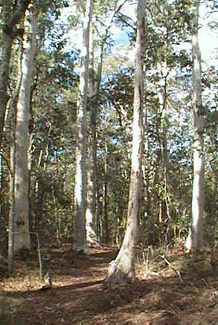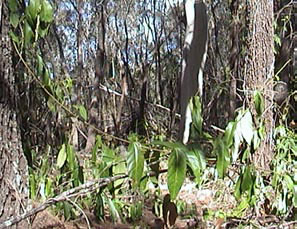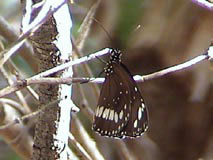Forward by Richard Rawlings, Land for Wildlife Officer, Brisbane City Council
Jak Guyomar and Ginny Saunders live close to the shores of Moreton Bay in the Lota Creek Catchment in the eastern suburbs of Brisbane. Theirs is a unique property in a unique area of Brisbane. Clearing for farming and now housing have heavily impacted the native vegetation so that these plant communities are some of the most threatened in Brisbane. Jak’s property has both Endangered and Of Concern regional ecosystems. Jak joined the Land for Wildlife program in May 1999 and three years later entered into a Higher Voluntary Conservation Agreement. After nearly 70 years of living in the area, Jak has provided the following account of his efforts to conserve native vegetation and wildlife habitat on his property.
The 4 hectare property is a remnant of an original about 100 acres purchased in 1919 by my maternal grandfather, which was part of subdivision called Grassdale Estate – Grassdale because of the profusion of Xanthorrhoeas. There is to my knowledge only one left in the wild. The name Grassdale was changed to Gumdale in the 1940’s.
The property was 80% cleared for farming. The remainder was harvested for useful timber with the “rubbish” trees left standing. Our property is part of this remainder. Hence the 100 – 150 year old Scribbly Gum trees. A lot of very old Lophostemon suavoelens were ringbarked and left standing. There is one of these still standing and from the girth it must have been around 150 years old when ringbarked around 1920. The main property was a general purpose farm, running 500 chickens and 100 pigs, and other farm animals at any one time.
I have lived on the property for 68 years, (I could not navigate my way out!) and have witnessed vast changes to the district in this time, from a farming community to the present tract housing estates.
Demand for land for housing is driving up the local valuations and hence the taxes, so that privately protecting Nature in this area is becoming more difficult. Witnessing the gradual destruction of the local bush environment has been very stressful. When Brisbane City Council put in place Vegetation Protection Orders in the early 1990’s I welcomed them. Then later the Land for Wildlife and Voluntary Conservation Agreement (VCA) programs were taken up by us with gusto! We intend to arrange a Conservation Covenant shortly.
The main tree cover on our property consists of Eucalypts and the canopy covers approx. 90% of the property. The main trees consist of 4 Eucalypt species, 4 Acacia species, 3 Melaleuca sp., 3 Banksia sp., 2 Lophostemon sp. and 4 Pioneer species other than wattles.

We have recorded around 155 species of plants so far of which around 90% are indigenous to the area. Some of the most interesting are several ground orchids that appear when conditions are right. In particular Hyancinth Orchid (Dipodium variegatum) which lives in a symbiotic relationship with a species of root fungus and numerous plants of Nodding Orchid (Geodorum densiflorum) are scattered through out the area.
Also in the understorey are significant areas containing 4 species of Lomandra (Matrush). Lomandras are exclusive host plants for the Trapezites genus of Skipper butterflies, with 6 species local to the area. A rare species, Trapeziteslutea (Rare White-Spot Skipper) can be found on occasion when conditions are favourable. Another understorey species which is significant to the local Skipper population is Saw Sedge (Gahnia aspera) which is host to the Hesperilla genus.
There are around 20 “grandfather” Scribbly Gums with multiple hollows.
These provide nesting and roosting sites for 4 species of parrot, as well as bats, possums, Sugar Gliders, kookaburras etc. So we have quite a nursery in season. The Birds Australia survey (conducted as part of the VCA program) in early May this year, recorded 32 species of birds. Koalas started to appear around the mid 1960’s and have been resident ever since.

I have been breeding butterflies in the wild on and off for the past 40 years, and have established a number of host plant species. I have recorded around 30 species of butterflies. In one of the Allocasuarina areas there is a roosting spot for the Common Crow butterfly. During breeding season there can be around 100 individuals there. The host plant Monkey Rope Vine (Parsonsia straminea) is endemic to the area.
Fire
Bushfires were a regular occurrence between 1920 and 1960, occurring about every 5 years. However there have been no burns on the property between 1960 and 2007. This has had the effect of slowing regeneration of the smaller species of the indigenous understorey which have been choked out. It would be of great benefit if somehow controlled burns could be implemented to help establish the natural systems of the area. However since the property is in a semi-urban area, this seems unachievable in the near future. Some socially acceptable method needs to be evolved. Step forward those in the know!

Weeds
The main weed infestation is Ochna serrulata, with around 50% of the property affected. Work on this continues with about 50% of the original coverage eradicated. Regrowth of native understorey is very slow, due to the continuing drought, so eradication is not happening as fast as the mind requires! Ho Hum!!
The indigenous regrowth is achieved from existing seed banks in the soil and planting local species propagated from seed. This helps perpetuate local provenance. We try to avoid introducing clines from other areas. This is not always possible, but every little bit helps.
Fishbone Fern was accidentally introduced 20 years ago and now covers around 200 square meters. It is being contained and slowly eradicated. At present in the drought it retains moisture and creates a microhabitat for many invertebrates and a family of Pheasant Coucals .
Our Home
Our home is situated in the middle of the 4 hectares and is positioned about ten metres from a giant gum tree – the oldest on the property. We have coexisted here with all the aforementioned birds, insects and fauna. We have never been bothered by mosquitoes or cockroaches here. The birds and the spiders seem to make short work of them.
We have a resident 3 metre Carpet Python who lives in the ceiling and it is a rare rodent who makes it into the place. We have a whole family of possums and we have to work hard to resist feeding them. They regularly visit us in the evening, usually around 8pm, often calling out, ‘Ca-ca-ca’. They often sleep in the day in a nest they have built in my workshop. They appear unafraid just like the birds that often hop into the house over the doorjamb to pick up crumbs from the floor under the table. We have two cocker spaniels kept within a fenced house yard and they take no notice of the resident wildlife who share our space.
Article by Jak Guyomar, Land for Wildlife landholder Gumdale, Brisbane City
